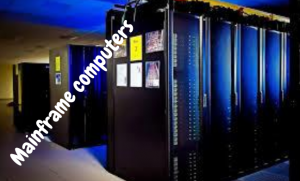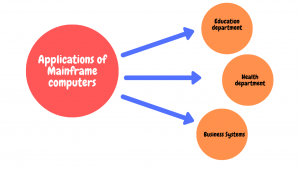Mainframe computers
What are mainframe computers?
Mainframes are really a type of computer commonly known for its big size, memory volume, computing speed, and high performance. Larger companies use these mainly for mission-critical applications demanding large amounts of data storage. There are generally some mainframe features prevalent to all mainframe sellers: approximately every mainframe gets the opportunity to manage (or multitude) various operating systems. Mainframes could add power to or quick swap devices without interrupt. Mainframes are expected to handle inputs and output ( I / O) of very massive density and to prioritize computational efficiency. A single mainframe may substitute thousands of smaller servers, or maybe even dozens.
A mainframe is indeed a high-performance system that is used for computing purposes on a widespread basis that needs greater flexibility that protection than a simpler machine would provide. Mainframes have traditionally been known with networks such as the internet instead of distributed computing, that although differentiation is distorting as narrower computers are becoming more strong and mainframes become even more cross-purpose. The main mainframes were installed in metal frames of square footage which is possibly where the inspiration came from. A standard mainframe may have consumed 2000-10,000 square meters in the background. The latest mainframes are almost the same length as big fridges.

Figure 1. Mainframe computer
The operating systems of mainframe computers.
The operating system is, in simpler terms, a set of commands that control the internal functioning of a computer system, its memory, processors, computers, and storage system. Mainframe operating systems are complex devices with significantly different features and objectives. Technologies are able to allow the optimum use of different resources of the machine and to guarantee that as rapidly as possible the full quantity of effort is performed. While an operating system could not improve a machine ‘s speed, it can improve resource usage, thus making the machine appear quicker and enabling it to perform more tasks in a short timeframe. The structure of a computer is composed of the services given by the computer system. The structure is different from the hardware layout, and in reality, different device designs can adhere to the structure of the very same device. In a way, the software, like a machine programmer, seems to be the computer as shown by the user. Part of the design for instance is the collection of software commands that can be understood and executed by the computer. The machine software and hardware form a highly sophisticated computer architecture, the culmination of generations of technical progress in the mainframe world.
Z operating system.
Z operating system is classified as a high-performance, highly versatile, and safe operating system and it is based on the architectural design of the 64-bit z. Unlike its successor, 390 operating system, z operating system promises to be super stable for applications that are mission critical applications to operate. The z operating system standard established an interactive web as well as Java. Usually, mainframes including z / OS are being used to manage large, complex, mission-critical tasks for large corporate organizations. Mainframes seem to be generally excellently-suited for large level data processing assignments. We can support thousands of users simultaneously and several programs that control computer resources, maintain terabyte size range servers and perform a high volume of traffic bandwidth communication channels. These workloads also involve the entering and delivery of real-time orders, financial transactions, payroll, inventory management, manufacturing. For example, a crowded web store might want to use a backend web mainframe server for safety, scalability, and reliability, whereas a bank could run its mainframe network of ATMs for much the same purpose.
The applications of mainframe computers.
There are various applications and uses of mainframe computers in real-life services. The mainframe machine is the best tool for carrying out millions of transactions in just one second. Mainframe computers are therefore used for the large-scale organization since they need to analyze large datasets throughout every second simultaneously. There are some firms, including such operational semantics, HSBN, Indian rail systems, ICICI and Cspgs, Tesco, Kenya strength, Verizon wireless, AIG, cola, Stolen bases, DHL, Mazda, Nyse, Adidas, Tata, Travelocity, Things up, USA Postal service providers and much more.
The use of mainframe computers in health care departments.
Health care is just another field that uses mainframe computers to both the maximum. As with e-businesses, every enterprise is using a system to keep track of numerous different transfers and manage them at such a rapid rate. Banking has to manage several things at once, so it doesn’t have much to report on what the healthcare system requires. That’s because there are hundreds of customers in healthcare companies but each of those patients comes with their very own private details. Not only does the company need to monitor a patient, but they also have to know whatever the person is taking medication, what medications they will need, what treatments they have or what their medications are. Each of these data points must be entered into a program and that’s where mainframe computers fall in.
The use of mainframe computers in the business system.
Traditional stores also use mainframe computers for decades, and these are most often used by large retailers worldwide. There are many explanations for this change, but the main explanation would be that the technology will make this both simple to track and manage stock. Every major retail company, whether it is slab-and-mortar or entirely online, wants to be able to manage its inventory efficiently as part of daily operation. A misjudgment or misunderstanding can lead to major problems that can pervade a whole organization. Mainframe computers help businesses prevent these problems by allowing them to easily manage huge transactions and store inventory data. Not only do retailers use the machines for production, but that is their key appeal for this business.
The use of mainframe computers in the education system.
Education is another very wide field, like an educational institution where people like staff, teachers, students, and others need to be monitored. The mainframe thus helps to store and retain all information that is relevant to its students and employees and gives higher management access to data.

Figure 2. Applications of Mainframe computer
Advantages.
The mainframe computer is capable of storing large quantities of data and running complex, ultra-computing programs. Mainframe computers can accommodate overly big power servers and can be used to incorporate several ultra-power processors, processing, and disk devices while simultaneously requiring massive data processing. The mainframe computer sector can be categorized into tiny linear and angular to remove the memory constraint using its application development property, and we can deliver great computer performance.